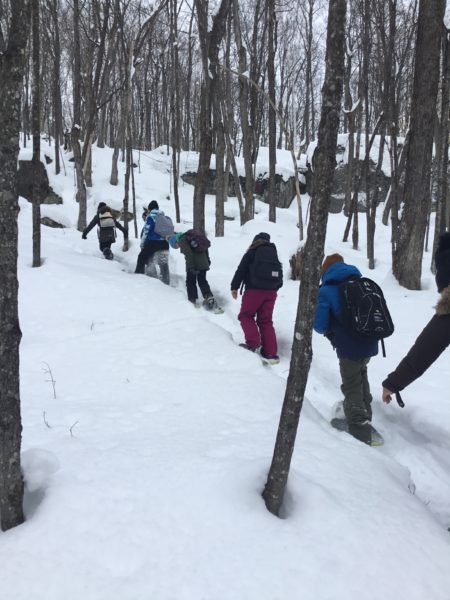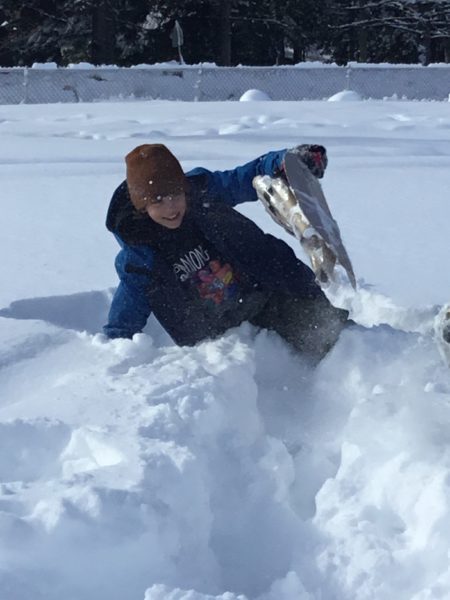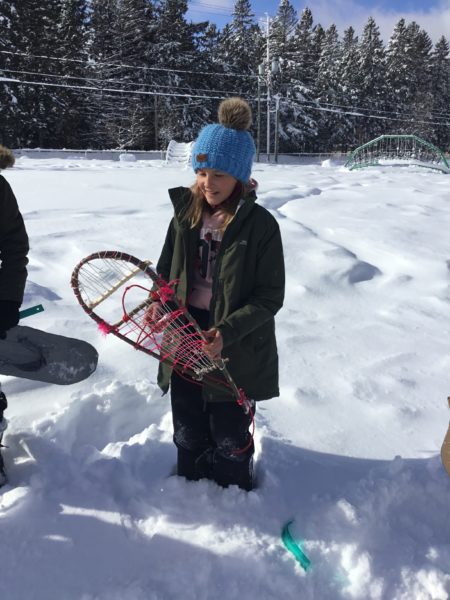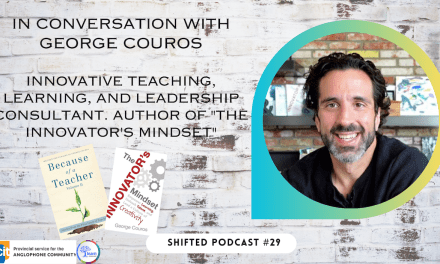Outdoor education has been widely promoted in recent years to educators. Many have adopted outdoor routines, especially at the Pre-K, Kindergarten and Cycle 1, while the upper cycle teachers (Cycle 3) are often torn by the desire to have their students experience the outdoors versus the need to fulfill the requirements of the curriculum and evaluation. Getting older students outside for exploration often comes with justifying the experience to parents and at times, colleagues and administrators. In fact, giving students an outdoors experience interweaves the whole curriculum and provides observation opportunities, skill acquisition, and work production to assess student abilities and understanding.

Students are full of curiosity, listening to their questions leads to so many amazing discoveries; I like to think of it as the “learning web”. Something I experienced while on a planned lesson to discover signs of life in the forest after a fresh snowfall, was that students became so distracted with questions about the snowshoes they were wearing that I had to let go of my lesson plan and listen to their curiosity. What ended my learning goal for students became the jumping-off point to a whole new investigation into why we float on snowshoes. Our conversation was anchored in the learning concepts of:
– Science: pressure and force;
– Math: square measurement, multiplication, and division;
– Social Studies: Indigenous knowledge;
– ELA: reading and writing; and of course,
– Being in nature.
Taking the time to go outside had students learn by experiencing what was literally right under their feet.
Students were generating questions which teachers usually try to elicit in the traditional classroom. Students were noticing, testing, and wondering about the features of their snowshoes – it was time to seize the moment and go with this engaged group on a different outdoor learning adventure!
The next objective, to help students make learning connections, was looking at the Quebec Education Program and project-based learning. Then, the topics began to emerge. STEAM – Design Your Snowshoes! In order for the students to get there, I needed to help them fill their learning toolkits. Searching to find relevant information, students would need to connect to each STEAM discipline:
Science: Pressure and Force – What makes snowshoes float on snow? Animal adaptations, how do some animals travel with ease on snow?
Technology: Discover how to help to distribute the weight of a person while they walk over deep snow, preventing them from sinking too far into the snow with every step.
Engineering: Defining the problem, brainstorming solutions, designing and building a prototype of the solution, testing the solution, and improving it.
Arts: Indigenous knowledge – Where did these snowshoes come from? Indigenous knowledge investigations. History of snowshoes – when were they first used? Creativity: What makes the snowshoe design important. Keep track of information in Nature Journals.
Math: What skills do we need to learn to build a snowshoe? Surface area, ratio, division, multiplication, kilograms per square centimeter.

The Backward Design with Assessment in Mind (Drake, Reid & Kolohon 2014) approach helped me identify what I want the students to be able to do by the end of this learning experience. In order for students to be able to design a snowshoe, they needed background knowledge. By explicitly teaching the topic of ‘area’ in Math, students then understood how to move to find the square area of their boot print. Similarly, in Science, when students had a good understanding of pressure and force, through other science learning and experiments, students could now apply that knowledge to their snowshoe design. All of this learning is what I refer to as a student “toolkit”. The “toolkit” is the student’s background knowledge, integrated learning, experience, vocabulary, understanding, etc. that I ask them to draw on, in order to carry out the goal: Design Your Own Snowshoes.
Toolkits full! Next, work. Students went about measuring, brainstorming, designing, creating prototypes, testing, and improving their personal snowshoes. Then it was test day. Everyone went outside again to test out each of the student designs. All snowshoes were unique and only a few met the performance challenge to travel 20 meters and have sufficient flotation! Prompting more questions!
All along this learning process, students continued to interact with the outdoors, testing designs in deep snow, hard snow, and crunchy snow! Students discovered that below zero temperatures did have an effect on materials used on their projects. This discovery led them to start keeping track of the weather forecast. Like the roots of a tree, the inquiry and connections just kept growing.
For evaluation, I observed student progress throughout this STEAM-based learning project through student questioning, engagement, interacting with others, predictions, logical reasoning, applying concepts, discussions, arguments, problem-solving, etc. As a final step, students were able to present their snowshoe design process from materials to the shape’s design. It was an extremely engaging activity, full of critically engaged learning that can be evaluated based on long-term knowledge retention.

Students who struggle with learning and/or behavior challenges in the classroom, are often observed as being connected and immersed in learning while outdoors. Outside, these students have freedom to move about physically. They are learning through different modalities by activating their senses and are often viewed as the experts in the outdoors by their peers.
As you know, during this pandemic, we lived through many waves of restrictions and social isolation, and there was more emphasis on screen time for work as well as for learning. This has all had negative effects on both students and educators alike. Mental health experts state repeatedly that there are tremendous benefits in being outdoors, citing some of the benefits as reducing stress and anxiety, encourages confidence and self-esteem, helps to improve mood and even emotions through increased serotonin levels, in addition to increased Vitamin D. As an educator, I am pleased to discover that all of these benefits not only help my students, but have a positive effect on my health as well! No wonder why we were all so enthusiastic during our snowshoe outing, it wasn’t just about our curiosity, it was about being outdoors to learn!
To sum up, this STEAM project was an example of the Quebec Education Program’s project-based learning. It checks off the Progressions of Learning in several, if not all, of the curricular areas of learning. It allows for differentiated learning and there was plenty of learning and skills development to evaluate. Finally, the Quebec MEQ Revitalization Plan for Educational Success actually sets outdoor learning as one of its priorities.
By taking my students outside to discover nature, by listening to student curiosity, acting on their inquiry, and then helping students access information, my job as a teacher shifted from knowledge keeper to what the Natural Curiosity authors describe as an “expert learner”. The expert learner is an educator who not only becomes passionate about what the students are learning, but how the students are making their discoveries through the learning experience (Anderson, Comay & Chiarotto 2017). Accepting that it is okay for me, the educator, to learn alongside students, is so enriching, especially for students and perhaps even more importantly to those struggling students.

In taking my students outside to discover nature, listening to student curiosity, acting on their inquiry, then helping students to access information, my job as a teacher shifts from knowledge keeper to facilitator. Best of all, I get to learn with my students.
We didn’t tackle my goal of discovering signs of life in the forest this time. Instead, being outside and experiencing the outdoors inspired curiosity, which in turn activated learning engagement in the outdoors. Rather than read about scientific concepts like force and motion in a text and drill area concepts in the Math workbook, getting my students outside to explore these concepts with an experiential framework was so much more meaningful and memorable to their learning development.
The moral of my story…
– Take your older students outdoors to inspire curiosity, all senses become engaged!
– Listen to your students: What are they wondering about? Invite critical thinking!
– While outside, permit yourself to let go of the Lesson Plan, let student curiosity drive discovery in learning outdoors!
– Remember, you don’t have to know everything, become a facilitator and share the responsibility of investigating and learning with students; this helps them fill their “toolkit”.
– Learning outside is connected to the QEP and actually promoted by the Revitalization Plan for Educational Success.
– Get outside often with your students, you never know what learning path you will end up taking!
– Remember, you don’t have to know everything to become an expert learner and share the responsibility of investigating and learning with students. This helps them fill their “toolkit”.
– Learning outside is connected to the Quebec Education Program and offers plenty of opportunities for educators to observe learning.
– Outdoor learning is actually promoted by the MEQ Revitalization Plan for Educational Success. Get outside often with your students, you never know what learning path you will end up taking.
In every walk with nature one receives far more than he seeks
-John Muir
This quote is so fitting for outdoor learning at the upper elementary cycles and secondary education. These students have so many questions, being in nature helps them make connections to authentic learning. So, get your students outside and see what they are curious about!
References
Anderson, D., Comay, J., & Chiarotto, L., (2017). Natural curiosity 2nd edition: The importance of indigenous perspectives in children’s environmental inquiry, Toronto, Canada: Marquis Book Printing.
Drake, S., Reid, J., Kolohon, W., (2014). Interweaving curriculum and classroom assessment: Engaging the 21st century learner. Don Mills, Ontario: Oxford University Press.






Essentially doing a good job at teaching science boils down to doing almost the complete opposite of what goes on in most Quebec schools… https://uvachemistry.wordpress.com/2022/04/05/how-do-a-great-job-at-teaching-science/